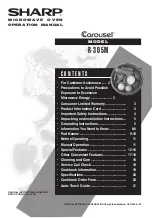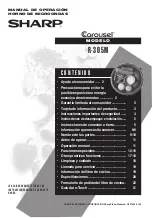
8
ABOUT MICROWAVE COOKING
•
Arrange food carefully. Place thickest areas towards
outside of dish.
•
Watch cooking time. Cook for the shortest amount
of time indicated and add more as needed. Food
severely overcooked can smoke or ignite.
•
Cover foods while cooking. Check recipe or
cookbook for suggestions: paper towels, wax paper,
microwave plastic wrap or a lid. Covers prevent
spattering and help foods to cook evenly.
•
Shield with small flat pieces of aluminum foil any
thin areas of meat or poultry to prevent overcooking
before dense, thick areas are cooked thoroughly.
•
Stir foods from outside to center of dish once or twice
during cooking, if possible.
•
Turn foods over once during microwaving to
speed cooking of such foods as chicken and
hamburgers. Large items like roasts must be turned
over at least once.
•
Rearrange foods such as meatballs halfway
through cooking both from top to bottom and from
the center of the dish to the outside.
•
Add standing time. Remove food from oven and
stir, if possible. Cover for standing time which allows
the food to finish cooking without overcooking.
•
Check for doneness. Look for signs indicating that
cooking temperatures have been reached.
Doneness signs include:
- Food steams throughout, not just at edge.
- Center bottom of dish is very hot to the touch.
- Poultry thigh joints move easily.
- Meat and poultry show no pinkness.
- Fish is opaque and flakes easily with a fork.
•
Check foods to see that they are cooked to the United
States Department of Agriculture's recommended
temperatures.
To test for doneness, insert a meat thermometer in a
thick or dense area away from fat or bone. NEVER leave
the thermometer in the food during cooking, unless it is
approved for microwave oven use.
•
ALWAYS use potholders to prevent burns when
handling utensils that are in contact with hot food.
Enough heat from the food can transfer through
utensils to cause skin burns.
•
Avoid steam burns by directing steam away from
the face and hands. Slowly lift the farthest edge of
a dish's covering and carefully open popcorn and
oven cooking bags away from the face.
•
Stay near the oven while it's in use and check cooking
progress frequently so that there is no chance of
overcooking food.
•
NEVER use the cavity for storing cookbooks or
other items.
•
Select, store and handle food carefully to preserve
its high quality and minimize the spread of foodborne
bacteria.
•
Keep waveguide cover clean. Food residue can
cause arcing and/or fires.
•
Use care when removing items from the oven so
that the utensil, your clothes or accessories do not
touch the safety door latches.
ABOUT SAFETY
I N F O R M A T I O N Y O U N E E D T O K N O W
T E M P
F O O D
145˚F
(63˚C)
...for beef, lamb or veal cut into steaks
chops or roasts MEDIUM RARE
160˚F
(71˚C)
...for fresh pork, ground meat, boneless
white poultry, fish, seafood, egg dish-
es, frozen prepared food and beef,
lamb or veal cut into steaks, chops
or roasts cooked to MEDIUM
165˚F
(74˚C)
...for leftover, ready-to-reheat refriger-
ated, deli and carry out “fresh” food,
whole chicken or turkey, chicken or
turkey breasts and ground poultry
used in chicken or turkey burgers.
NOTE: Do not cook whole, stuffed
poultry. Cook stuffing sepa-
rately to 165°F (74ºC).
Содержание R-305M
Страница 23: ......
Страница 30: ...9 12 13 1 5 9 14 3 2 4 6 11 3 10 ...









































